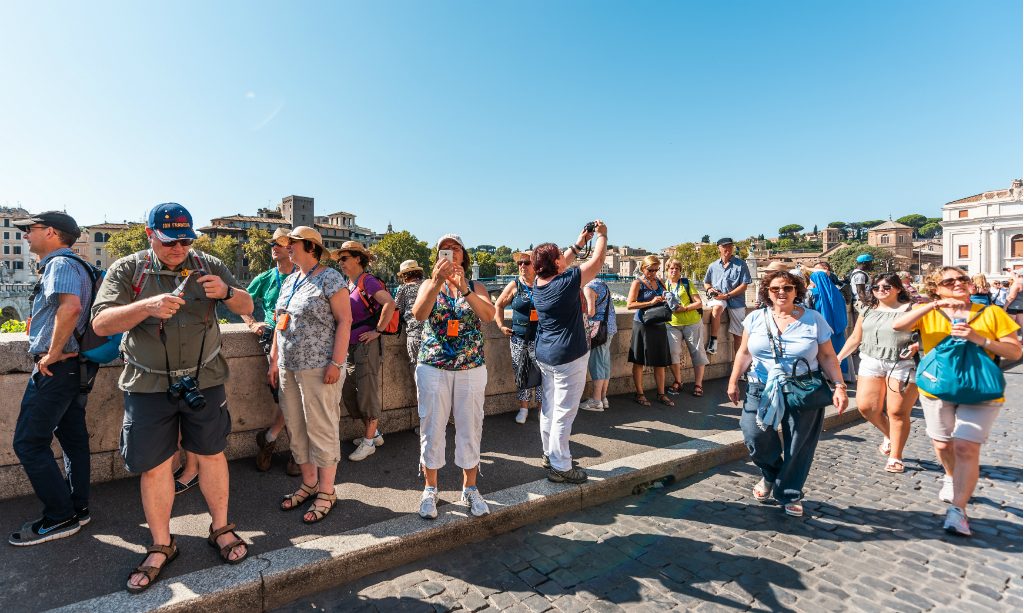In addition to climate change, there is no question that overtourism is the monster challenge defining the today and the tomorrow of the global tourism ecosystem. In his closing keynote address during the 2018 Adventure Travel World Summit in Tuscany, the Adventure Travel Trade Association’s (ATTA) CEO, Shannon Stowell, said, “Both overtourism and climate change seem to be the twin threats. When I look to the future of adventure travel, or travel at all, these are key problems we need to mitigate, reduce, and eradicate.”
While the word overtourism is present in our everyday realities, our work with different partners around the globe reveals there is still dangerous ignorance within our adventure travel community about the phenomena. This is ignorance because, more often than not, businesses and tourism authorities declare the problem does not relate to or concern them. This is dangerous because, in reality, overtourism is a threat to all of us: every traveler, every business, every destination, and every organization in the global tourism industry.

Perhaps the issue is we don’t fully understand or appreciate the scope and reach of overtourism. Maybe it feels elusive in our everyday business operations. Or maybe we find ourselves falling victim to issue fatigue as we try to grapple with complex universal problems like overtourism and climate change, which require massive undertakings from within the tourism industry and beyond. The truth is we can’t push overtourism off as someone else’s issue, and until we understand it and acknowledge its existence, we cannot address it.
This is why we would like to share our thoughts and insights about overtourism. We want to help lead our community and the industry at large to a place of agreement that allows and empowers all of us to acknowledge, act upon, and prevent this problem that will define the future of our ecosystem.
What is overtourism?
In general, overtourism occurs when there is a disparity under one of three conditions:
- Between the volume of tourism activity and the capacity of the host destination.
- Between the type of tourism activity and local capacity.
- Between traveler behavior and local social norms.
Overtourism can occur when the style of a tourism activity does not match the nature of the local destination and its physical ability to sustain it without being damaged. For example, visiting a centuries-old town with a fragile infrastructure in a motorized vehicle instead of exploring by foot, or riding a motorboat through a biodiversity-rich delta instead of kayaking.
A disparity between traveler behavior and local social norms can also be classified as overtourism. This disparity does not always result from overcrowding. Travelers might not overwhelm in volume, but they behave in disrespectful ways that irritate local residents, leaving behind a vibe that their presence as tourists has crossed a line. A prime example is the regularity of incidents with tourists “refreshing” their bodies or feet in fountains throughout Rome.
Defined as one of these three conditions, overtourism is a much more frequent phenomena than the cases of large-scale overcrowding widely cited. And it is. It is much more prevalent than many of us are willing to admit.
Why does overtourism happen?
The travel and tourism industry’s growth and development has created the conditions under which overtourism has flourished. According to the World Travel & Tourism Council, the tourism industry has been growing steadily with 3.9 percent growth in 2018 — and it’s expected to continue growing. This explosion of travelers embarking on domestic or international trips compared to previous years means destinations across the globe are seeing an influx of travelers at an unprecedented rate and in unprecedented numbers.
In this context, there are two factors from the past decade that led to the rise of overtourism. The first factor is short-term thinking and unsystematic tourism planning. Our industry is complex, multifaceted, and linked to many other sectors such as transportation and agriculture. While tourism can generate substantial benefits for businesses and destinations, it requires careful planning both within the tourism sector and in conjunction with other tangential industries to ensure there is a net positive balance between the resources it consumes and the gains it produces. The need for careful planning has been undermined, and it is one of the reasons we are faced with excessive tourism growth.
The second factor that has led us to our current condition is acceleration of growth fueled by contemporary phenomena such as the peer economy, highly accessible transportation (like low-cost airlines), and social media. Both of these factors are worth a close examination.
Unsystematic Tourism Planning
Though overtourism is a relatively new phenomenon, some of the factors defining its prevalence can be found in existing literature on managing tourism growth. There are three key concepts that need to be pulled out from tourism planning textbooks and introduced into the awareness of every professional in the tourism community: carrying capacity, limits of acceptable change, and visitor flow management.

Carrying capacity is the capacity of a place to sustain tourism activity without suffering from damaging impacts. Carrying capacity can be physical. For example, estimating the maximum number of people a hiking trail can sustain at the same time before it malfunctions, putting hikers at risk, or estimating the maximum number of tourists who can stay in a village without overwhelming the local water supply system.
Carrying capacity can be also psychological. For example, estimating how many tourists can be present in a small-town square without disturbing local residents, or how many people can be at a landscape observation point with someone before he or she feels overcrowded and walks away with a sense that the experience has been ruined. Do these examples remind you of overtourism stories?
Limits of acceptable change is the extent to which local stakeholders are willing to tolerate changes to their hometown or local area in exchange for a growing tourism economy. This means local community members are presented with a plan for development along the nearby wild beach coastal area, and they can decide if they are willing to accept development of the entire area or would like to limit development to only 20 percent of the beach and leave the rest in its naturally beautiful state. This means allowing the development of only one resort complex instead of five.
Limits of acceptable change can relate to development within towns as well. It can include identifying unacceptable construction projects like large hotels that may overwhelm traditional architecture or the entry of coach buses in downtown areas that may increase pollution and congestion.
Visitor flow management is the planning process that influences how tourists move through a destination. This is possible if there is a general idea of how many tourists are likely to be in your destination on any given day, what places they will attempt to visit, and what patterns will likely follow in their movement. Based on this information, it is possible to influence and guide flows in ways that secure high-quality experiences for guests and limit pressure on local places, people, and resources.
Visitor flow can be influenced by many things such as attraction hours, itinerary designs, guiding and information services, pricing, and regulations. Some destinations, such as Amsterdam, are using technology to effectively pursue proactive management of visitor flows but many destinations and attractions are under pressure because they have ignored the importance of visitor flow management and are now struggling with overtourism’s consequences.
Contemporary Socio-Economics
Destinations used to have time to plan and prepare for growth. Today it happens so fast, and local residents, businesses, and authorities are often caught off guard. In addition, tourism growth was previously determined by the construction of new hotels and room availability in the area. This meant arrival increases were relatively easy to predict because hotel development takes time. Today, the increase of peer accommodations has left many destinations unaware of their bed capacities, and they are unable to foresee spikes in arrivals.
The increase in arrivals is facilitated by the rise of low-cost airlines, which led to increased and affordable accessibility. In just a few years, the volume of travelers who were suddenly able to visit more destinations often for shorter periods of time threw even experienced destinations into shock. Partnership agreements with new airlines and launching new routes used to take time to produce effects; today this can unfold much faster.
Social media’s role across the tourism landscape in general has exacerbated the problem. Facebook, Twitter, and Instagram have become platforms for sharing bragging rights and selfies from trips, producing sudden waves of visitation and traumatizing otherwise remote and quiet places. For example, the sudden tsunami of visitors to Lake Elsinor, California, to see the poppy superbloom motivated by Instagram photos led to the event being called an Insta-pocalypse.
In an environment of fast growth, violating key growth management principles mixes very poorly with the dynamics of the peer economy, the increase of low-cost airlines, and social media’s influence. While this is not good news, it is helpful in understanding overtourism’s underlying causes. This is the first natural step in managing and overcoming the overtourism problem.
At the ATTA, the belief that tourism is a force for good is part of our DNA. Excessive tourism is not a threat we’re willing to ignore and hide from but rather an opportunity to put in the work and find solutions to “mitigate, reduce, and eradicate” it. This will require committed actions on behalf of destinations as well as governments, businesses, non-governmental organizations, media, and other partners in our community. There is no one-solution-fits-all answer to the problem. However, we want to work with partners both in the tourism industry and beyond to begin identifying smart destination-level approaches that develop the foundation for healthy tourism that generates economic benefits and eliminates the risk of harmful overtourism. Let us know what you think and what you would like to see happening.
